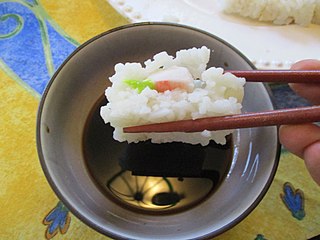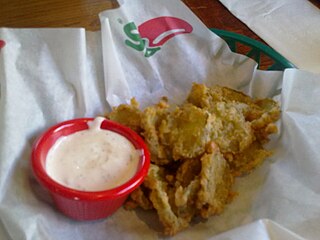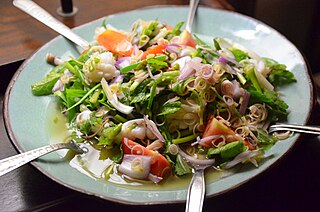
Thai cuisine is the national cuisine of Thailand.

A salad is a dish consisting of mixed, mostly natural ingredients with at least one raw ingredient. They are often dressed, and typically served at room temperature or chilled, though some can be served warm.

Belgian cuisine is widely varied with significant regional variations while also reflecting the cuisines of neighbouring France, Germany and the Netherlands. It is sometimes said that Belgian food is served in the quantity of German cuisine but with the quality of French food. Outside the country, Belgium is best known for its chocolate, waffles, fries and beer.

Rémoulade is a European cold sauce based on mayonnaise. Although similar to tartar sauce, it is often more yellowish, sometimes flavored with curry, and sometimes contains chopped pickles or piccalilli. It can also contain horseradish, paprika, anchovies, capers and a host of other items.

A dip or dipping sauce is a common condiment for many types of food. Dips are used to add flavor or texture to a food, such as pita bread, dumplings, crackers, chopped raw vegetables, fruits, seafood, cubed pieces of meat and cheese, potato chips, tortilla chips, falafel, and sometimes even whole sandwiches in the case of jus. Unlike other sauces, instead of applying the sauce to the food, the food is typically placed or dipped into the sauce.

Blue cheese dressing is a popular side sauce, salad dressing and dip in the United States. It is usually made of some combination of blue cheese, mayonnaise, and buttermilk, sour cream or yogurt, milk, vinegar, onion powder, and garlic powder. There is a blue cheese vinaigrette that consists of salad oil, blue cheese, vinegar, and sometimes seasonings.

Green goddess is a salad dressing, typically containing mayonnaise, sour cream, chervil, chives, anchovy, tarragon, lemon juice, and pepper.

Crab Louie salad, also known as Crab Louis salad or the King of Salads, is a type of salad featuring crab meat. The recipe dates back to the early 1900s and originates on the West Coast of the United States.

Seven-layer salad is an American dish that includes a colorful combination of seven layers of ingredients: iceberg lettuce, tomatoes, cucumbers, onions, sweet peas, hard boiled eggs, sharp cheddar cheese, and bacon pieces. The salad is topped with a mayonnaise-based dressing and sometimes sour cream is added. It is often served in a glass bowl or large pan so the layers can be observed. The dish is often associated with potlucks, picnics, and barbecues, where a large gathering of people takes place and many people need to be fed. There are many variants of the seven-layer salad and it can be made with additional layers, making it an eight-layer salad instead.

Olivier salad is a traditional salad dish in Russian cuisine, which is also popular in other post-Soviet countries and around the world. In different modern recipes, it is usually made with diced boiled potatoes, carrots, brined dill pickles, green peas, eggs, celeriac, onions, diced boiled chicken or bologna sausage, and tart apples, with salt, pepper, and mustard added to enhance flavor, dressed with mayonnaise. In many countries, the dish is commonly referred to as Russian salad. A variation called Stolichny salad exists, and is also popular in the Russian cuisine.

Shrimp Louie is a traditional salad from California made with shrimp, lettuce, egg and tomato. The dressing is similar to Thousand Island dressing and is made with mayonnaise, ketchup, chili sauce, Worcestershire sauce, onion, salt, and pepper. Shrimp Louie originated in San Francisco in the early 1900s. A variation on the salad includes avocado. A version made with crab is known as Crab Louie.

Thousand Island dressing is an American salad dressing and condiment based on mayonnaise that can include olive oil, lemon juice, orange juice, paprika, Worcestershire sauce, mustard, vinegar, cream, chili sauce, tomato purée, and ketchup or Tabasco sauce.

Salads that are internationally known as Thai salads, with a few exceptions, fall into four main methods of preparation. In Thai cuisine these are called yam, tam, lap and phla. A few additional dishes can also be regarded as being a salad.














